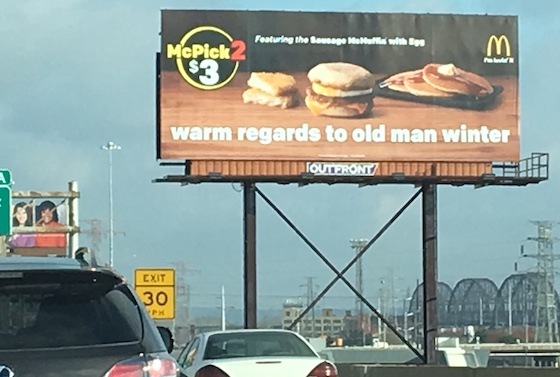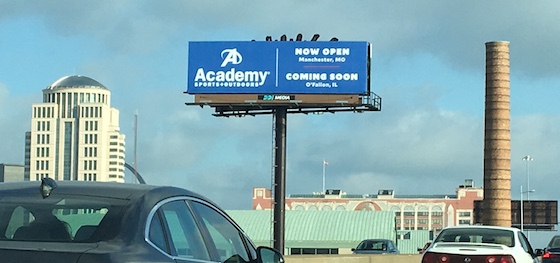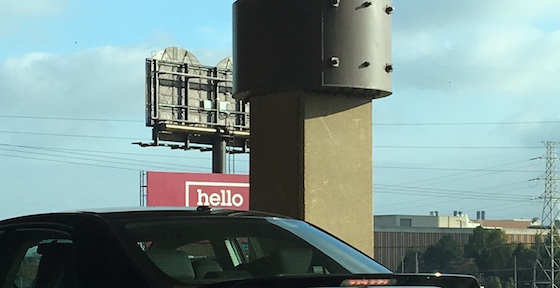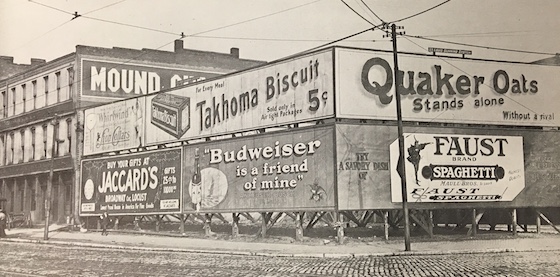Memo From Frank
It’s hard to believe that the Holiday Season is here again. Time seems to pass too fast. The year end is a time of reflection, and the downtime of the holidays is a good time for goal setting for the coming year. If you want to develop a significant income stream from billboard signs – as a supplement to your current finances or a safety line for replacement of your day job – then the time to take action is now. Santa Claus can come every month if you are collecting a check from your billboard advertisers. So don’t let Christmas only come once per year – try to make it a monthly occurrence. And I would like to take this opportunity to extend a Happy Holidays to you! I look forward to carrying on this conversation in the New Year.
Can You Add Another Advertising Face To That Sign?

One great opportunity, that many people overlook, is the ability to add a “back” side to an existing one-sided sign. I have done this many times and it’s probably one of the highest return-on-investment concepts that you can do. But there are many issues you have to consider.
Is it legal?
The first question that should always come up is the issue of whether or not you can legally add a second side to a one-sided sign. This will require researching the permit. In some instances, the sign was permitted for two sides and only one was easy to rent, so over time the second side simply went away. It is inadvisable to do illegal things, as you can get caught, fined, and destroy relationships with city and state sign inspectors.
Is it physically possible?
If it’s legal to add a second side, the next question is if it is physically possible to add the second side. To do so includes placing heavy panels on that vacant side, as well as having the correct safety equipment to meet OSHA and even room to install the ratchets for the vinyl installation. In some cases – particularly on roof mounts – it may be impossible to place the sign face and accommodate the angular sign supports.
Is there decent visibility to that side?
In some cases, the second side of the sign is missing simply because it can’t be seen. Bridge piers or a forest of trees may render some signs as simply only one face out of necessity. But often times the item blocking the sign has disappeared over the years, and that second fact is now completely visible.
Is there demand for that ad space?
Another factor that is a big part of the algorithm to adding a second face on a sign is if there is sufficient demand to rent the ad space on it. Sometimes – particularly in a rural area – there is only advertiser demand in one direction, typically towards the town. If the nearest advertiser on the missing side is 100 miles away, then it might not be practical to rent that face.
What’s the cost vs. economic return?
The final step is pure economics. To install the missing face will cost a certain amount of money, and the projected revenue less expenses yields a certain net income. So what does the money look like? If it costs $5,000 to bring that side back to life, and it only rents for $199 per month and nets $75 per month is simply not worth the investment.
How to structure the deal
You have basically two options in adding a second side to a sign. The first is to sub-lease that vacant side from the existing billboard company that owns the sign, and then build it and rent it and, after the sub-lease, make a profit. The second option – if the sign is owned by an advertiser like a truck stop – is to bring that vacant side to life in exchange for a small monthly amount to the sign owner.
Conclusion
If you do it right, adding a face back onto a one-sided sign can be highly profitable. When you see one-sided signs that have good potential, you should take note as they might offer a great income stream.
Which Sign Makes More Money?


Which if the two signs shown above makes more money? This is kind of a trick question, because I’m not saying “which has higher revenue” but instead “which has a higher return on investment”? And the answer is probably not what you think. The steel monopole sign has a return-on-investment of probably around 10%, while the wooden sign has a return on investment of around 50% -- that’s five times more. What this means is that you would be better off with 5 wooden signs than one steel sign in this case – you would have the same revenue but much greater cash in your pocket. Don’t overlook the opportunities in wooden signs in medium-sized markets. They may be small but they have large returns.
Billboard Home Study Course
![]() How to Find a Billboard Location
How to Find a Billboard Location
![]() How to Buy a Billboard
How to Buy a Billboard
![]() How to Build a Billboard
How to Build a Billboard
![]() How to Operate a Billboard
How to Operate a Billboard
![]() How to Rent Ad Space on a Billboard
How to Rent Ad Space on a Billboard
![]() How to Sell a Billboard
How to Sell a Billboard
Get Your Copy Now!
Left-Hand Reads Vs. Right-Hand Reads


Not all signs are created equally. Signs typically have two sides: the “right-hand read” and the “left-hand read” (which describes which side of your body the sign is located on). And the right-hand read is much more favored than the left-hand read (kind of like a Side A and Side B on a record). But there can be circumstances where the left-hand read can be the stronger one. So what’s the truth about right-hand and left-hand reads?
The right-hand read has greater visibility
There’s no question that the right-hand read of the sign has greater visibility than the left-hand read. The main reason is simply geography – the right-hand read is significantly closer to the passengers in the car viewing it, as opposed to a sign that is located hundreds of feet across the other side of the highway. This fact never changes and is the main force that makes the right-hand read preferred by most advertisers (in fact, some will simply not rent left-hand reads no matter what).
The right-hand read has a longer read
Because of the angles of approach, the right-hand read has a longer read than the left-hand read. You can easily test this hypothesis when driving down the highway. You’ll see that the angle created by the distance from the driver makes the actual time you can see the advertisement on the left-hand read is reduced significantly – at the same time that you can still read the right-hand read you are looking at the edge of the sign on the left.
The left-hand read can be improved with a “V”
Many billboard owners try to battle the reduced visibility of the left-hand read by increasing the “V” – the angle created by the edge of the sign nearest the road vs. the back edge. A giant “V” can angle the left-hand read and increase the effectiveness of the sign, but at a large cost. The most severe “V” structures can cost 50% more than a simple back-to-back unit.
The left-hand read can be more desirable based on the direction of advertisers
This is the only time in which a left-hand read can beat a right-hand read. If there are 100 times more advertisers going north-bound than south-bend, and the north-bound side of a sign is a left-hand read, then it will have more marketability than the south-bound right-hand read. That’s why you will see certain markets in which every sign in one direction is full – both right-hand and left-hand – and the other direction is completely vacant on every sign.
Conclusion
In most applications, the right-hand read always prevails over the left-hand read. It is more desirable, more visible, and this cannot be argued. However, the left-hand read, particularly with combined with a significant “V”, can still be marketable if there are sufficient advertisers in that direction.
The Truth About Obstructions

Billboards are all about visibility. But what do you do when there’s an obstruction that ruins the advertising value of a sign. How do you attack that problem? Here are some concepts to be aware of.
Can the obstruction be legally removed?
Not all obstructions are created equally. Some are privately owned and some are publicly owned. It is rare than you can remove a publicly owned obstruction, such as a tree on the state right-of-way. And, of course, there are certain obstructions that cannot be removed at any price, such as a bridge. But most privately-owned obstructions can be legally removed with the permission of the property owner. Examples of these type of obstructions might be a premise sign, a tree, or a flag. The penalties on removing publicly-owned obstructions can include huge fines or even jail, so it is never recommended to get involved in such a project.
Can the obstruction be minimized legally?
Some obstructions cannot be removed, but can be minimized. This often opens the door even to obstructions on publicly-owned property. For example, in some states you can trim trees in front of signs with permission from the highway department. There is not nearly as much pushback when attempting to minimize an obstruction as opposed to removing it.
What is the effective read of the sign after these things have been fixed?
Before you even think about removing the obstacle on a billboard, it is important to see if the net effect is worth the effort. If the sign is still suffering from a short read – despite removal of the obstructions – you may decide that it’s simply not worth the effort. Many a sign owner has let a sign sit with blockage because it’s not worth the month to bring it back to life.
Do all proactive steps only after you have everything in writing
One thing’s for sure when eliminating blockages to billboards: you have to get it all in writing before you begin. Here’s an example. I once bought a billboard that had such bad blockage that it had been vacant for 20 years. There was a premise sign right in the center that said “Park Here”. The sign company had given up hope. So I approached them about buying the sign structure at an extremely low price – saying that I was going to try to simply rent the ad space for a low price despite the premise sign in the middle. I got everything in writing. I then contacted the parking lot owner, and he agreed to allow me to lower his sign so the blockage vanished. Of course, as soon as I accomplished that, the sign owner was insanely mad that I’d bought the sign for next to nothing and then removed the obstruction. That’s why it is essential to get everything legally bound in writing before fixing the problem.
Make sure the obstruction does not reappear
Once you have fixed the obstruction, make sure that it does not reappear later. If you got permission to trim back a tree, make sure that you have an agreement to go in and trim it continually for a small fee per year. Remember that trees grows quickly, and you may need to touch-up the obstruction at least once or twice a year. These contracts are generally called “maintenance agreements” and give you the right to trim things for an annual rent.
Is the sign marketable even with the obstruction?
You could probably build an entire business out of just solving obstructed signs. But sometimes you don’t have to even remove the obstruction. In a good market and on a road with high traffic, even signs with obstructions are marketable at reduced rates. I have been shocked in many cases at the rents that can be achieved despite blockage. Part of the solution is to use large letters and attention-getting colors to overcome the visibility drawbacks.
Conclusion
There is really good opportunity in buying signs cheap that have poor visibility and then removing the obstructions. Just make sure that such removal is legal, possible, and get everything in writing. Even if the obstruction cannot be removed, it is possible to often rent these signs at reduced rates. So watch for these opportunities when you are in the field.
A Very Quick History Of The Billboard Sign

Billboards have been around since ancient Egypt, when the first billboard was a boulder with an ad message for a place to board camels. Billboards have been built to reach a wide variety of audiences throughout history, from pedestrians to bicyclists, to train passengers, to those riding in automobiles. The fundamentals of billboards have remained virtually the same for centuries: 1) large in size 2) low in maintenance 3) reaching a captive audience and 4) point-of-purchase allowing to reach customers at the very moment they are making a decision (like McDonald’s Exit Now). This very simple business model has created very high returns and several billionaires including Ted Turner, Artie Moreno and John Kluge. Despite the advent of the internet – which destroyed the audience for conventional advertising institutions like newspapers, television and radio – billboards seem insulated from competition. And that competition has also been eliminated by the Highway Beautification Act which made the billboard industry a federally-controlled industry since the 1960s, thereby limiting supply and creating permanent value for every billboard in the U.S.
The Market Report
Prices Are Delayed By At Least 15 Minutes
